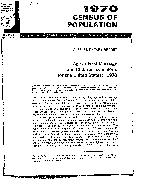1970 Census of Population, Subject Reports: Childspacing and Current Fertility
1970 Census of Population, Subject Reports: Childspacing and Current Fertility
This report presents statistics for the United States on the fertility histories of women in terms of the numbers of children born by reconstructed successive ages and successive marriage durations. The data are based on the 1970 Census of Population, which was conducted as of April 1, 1970.
The text consists of an introduction and Appendices A through E, which appear after the tables.
Content of the Tables
- Tables 1-26 – rates of first marriages and births, cross-classified by urban-rural residence, race, Spanish origin, education, occupation of husband (for women married once with husband present), occupation of woman, family income in 1969, and ratio of family income to poverty level in 1969
- Tables 27-38 – data on spacing of births in relation to the mother's date of first marriage, cross-classified by the same characteristics listed above for tables 1-26 and by age at first marriage and number of times married
- Tables 39-45 – show probabilities of first, second, and third order births at various intervals since first marriage for women in 5-year marriage cohorts
- Tables 46-48 – numbers of women in marriage cohorts from 1955 to 1969 according to their labor force status and number of children ever born
- Tables 49-51 – spacing of births among remarried women as compared with women married only once
- Tables 52-65 – births 0-4 years ago and own children under 5 years old to age of woman, cross-classified by urban-rural residence, race, Spanish origin, marital status, education, labor force status, occupation of husband, family income in 1969, and relationship to head of household
- Tables 66, 67, and 70 – annual birth rates for single years and/or averaged annual birth rates for 5-year periods from 1955 to 1969
- Tables 68, 69, 71, and 72 – percentage distributions of first births in calendar periods by the interval from first marriage of the mother or of second and higher order births by the interval from the previous birth to the same mother, cross-classified by race
- Tables 73-87 – averaged annual probabilities of first, second, third, fourth, and fifth and higher order births, cross-classified by urban-rural residence, race, age of woman, 5-year calendar periods from 1955 to 1969, and interval from either first marriage or birth of previous child
- Tables 88-98 – comparative distributions of women according to whether or not they had borne children before their first marriage, cross-classified by race, age at birth of first child, education of woman, age at first marriage, labor force status of woman, family income in 1969, and education, occupation, and income of husband
- Tables 99-102 – patterns of progression from first to second child and from second to third child according to the sex of the previous child, cross-classified by race, education, and labor force status of the mother
- Tables 103-107 – distributions comparing women with all children ever born still present in the household to women with one or more children ever born absent from the household, cross-classified by race, duration of marriage, and age
- Table 108 – single and multiple births in specified calendar periods by age of mother and number of children in the birth event by whether or not the date of birth was allocated
Appendices
- Appendix A. General Information Concerning the Data
- Appendix B. Area Classifications
- Appendix C. Definitions and Explanations of Subject Characteristics
- Appendix D. Accuracy of the Data
- Appendix E. Publication and Computer Summary Tape Program
Sample size. The statistics in this report, with the exception of those in tables 66, 67, 70, and 73 through 87, are based on the 5-percent sample. The statistics in tables 66, 67, 70, and 73 through 87 are based on a 1-percent sample. The sample data are weighted to represent the total population (see "Data Collection Procedures" in Appendix A. The sample weights in the 5-percent sample have unequal values, whereas the sample weights for the 1-percent sample all equal 100; hence the numbers shown from the 1-percent sample end in "00", whereas those shown from the 5-percent sample may end in any combination of digits.
Chapters
Download Full Report
A Note on Language
Census statistics date back to 1790 and reflect the growth and change of the United States. Past census reports contain some terms that today’s readers may consider obsolete and inappropriate. As part of our goal to be open and transparent with the public, we are improving access to all Census Bureau original publications and statistics, which serve as a guide to the nation's history.






